Scenario Analysis: Addressing Workload Worries in Pediatric Care Unit
VerifiedAdded on 2022/11/13
|8
|2094
|350
Report
AI Summary
This report provides a comprehensive analysis of a workload scenario within a tertiary care facility's pediatric unit. It examines the challenges faced by a new nursing unit manager, including issues of employee workload, frequent sick calls, low productivity, and lateness. The analysis delves into the causes and effects of these problems, referencing relevant literature on nursing management and leadership. The report proposes the application of a six-step problem-solving process to address the identified issues, detailing each step from problem identification to solution standardization. Recommendations include setting achievable deadlines, improving communication, clearly defining staff roles, and reviewing current workloads. The report concludes by emphasizing the importance of proactive workload management for improved patient outcomes and employee well-being, offering a practical guide for healthcare leaders to navigate similar challenges.
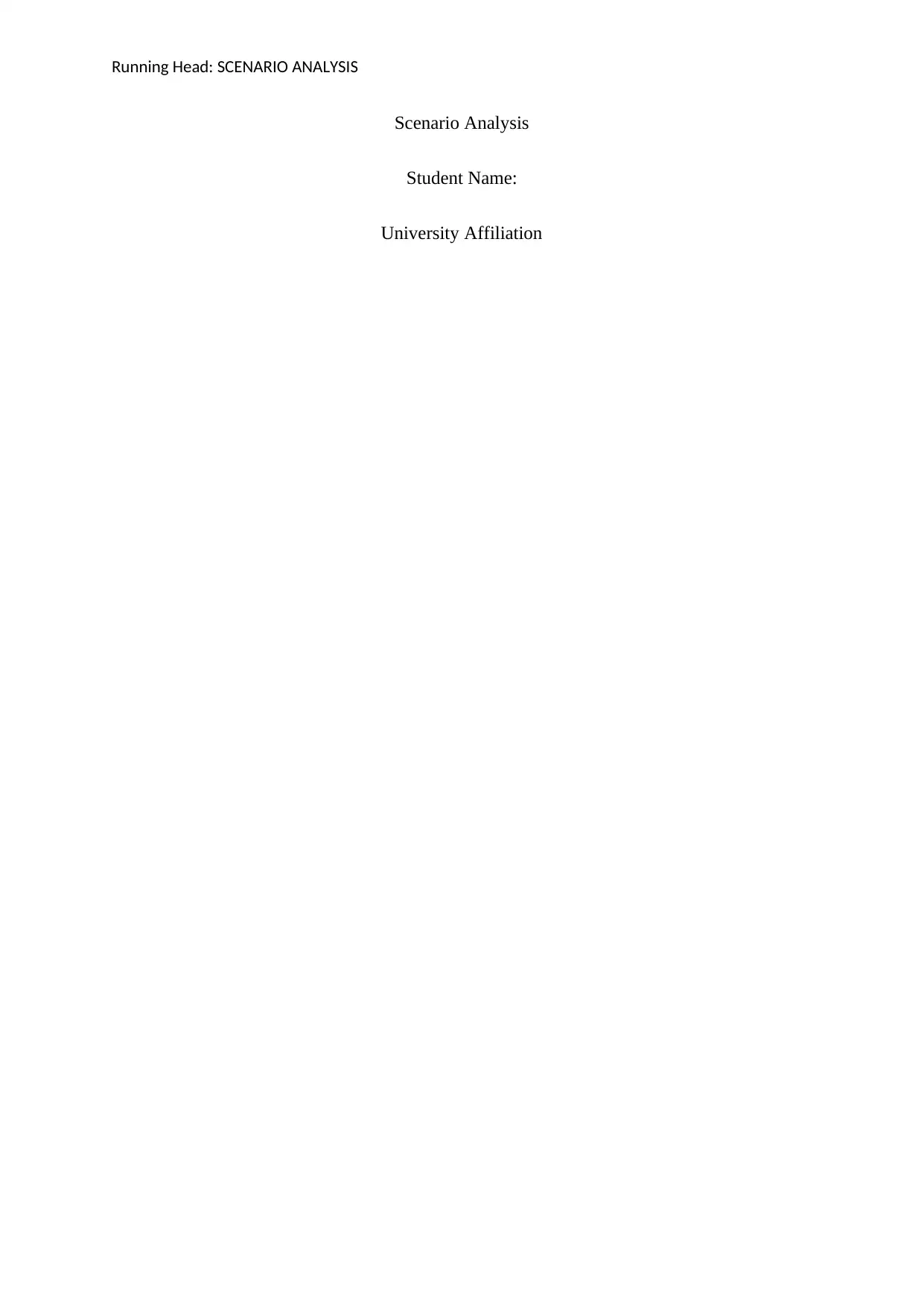
Running Head: SCENARIO ANALYSIS
Scenario Analysis
Student Name:
University Affiliation
Scenario Analysis
Student Name:
University Affiliation
Paraphrase This Document
Need a fresh take? Get an instant paraphrase of this document with our AI Paraphraser
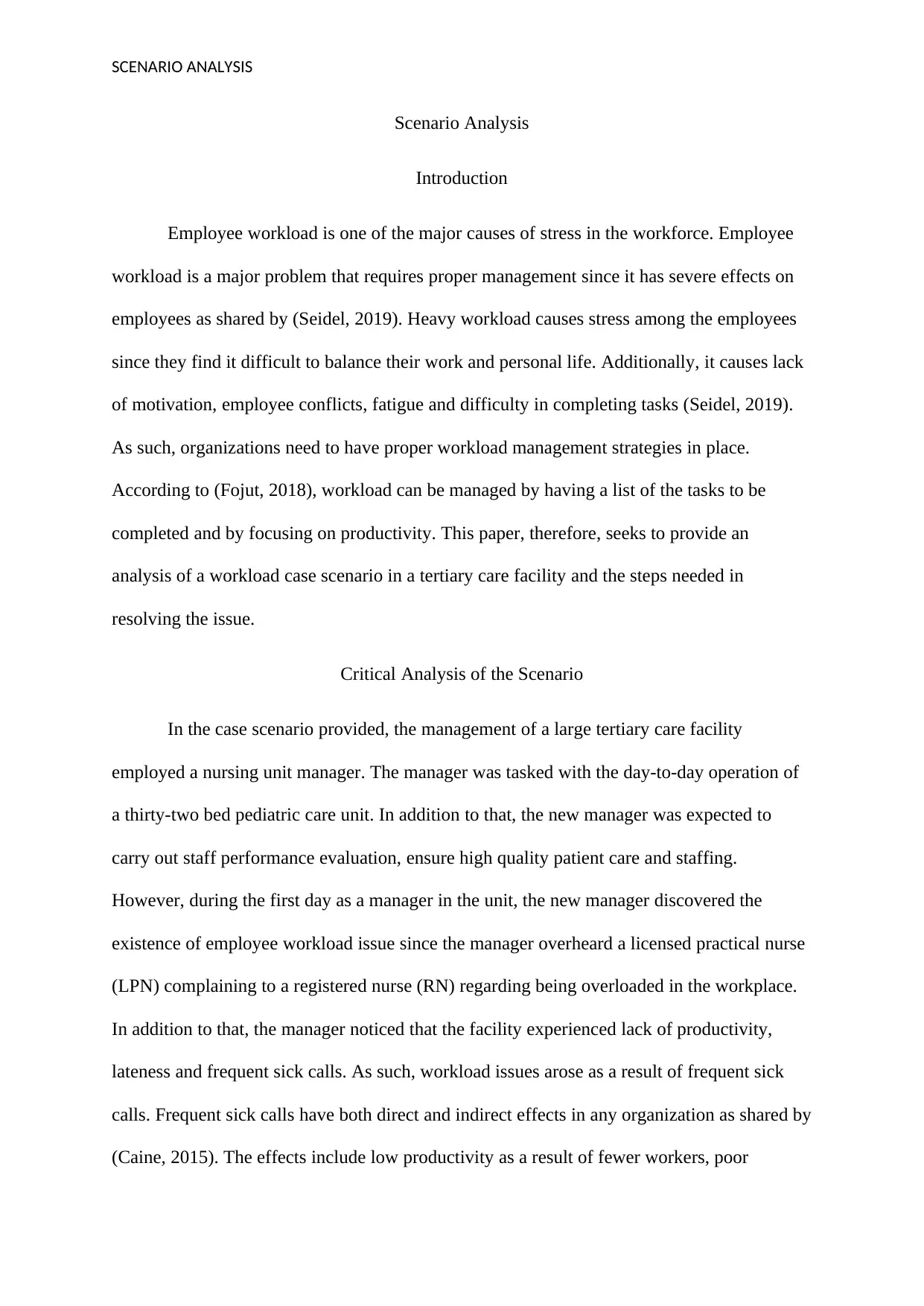
SCENARIO ANALYSIS
Scenario Analysis
Introduction
Employee workload is one of the major causes of stress in the workforce. Employee
workload is a major problem that requires proper management since it has severe effects on
employees as shared by (Seidel, 2019). Heavy workload causes stress among the employees
since they find it difficult to balance their work and personal life. Additionally, it causes lack
of motivation, employee conflicts, fatigue and difficulty in completing tasks (Seidel, 2019).
As such, organizations need to have proper workload management strategies in place.
According to (Fojut, 2018), workload can be managed by having a list of the tasks to be
completed and by focusing on productivity. This paper, therefore, seeks to provide an
analysis of a workload case scenario in a tertiary care facility and the steps needed in
resolving the issue.
Critical Analysis of the Scenario
In the case scenario provided, the management of a large tertiary care facility
employed a nursing unit manager. The manager was tasked with the day-to-day operation of
a thirty-two bed pediatric care unit. In addition to that, the new manager was expected to
carry out staff performance evaluation, ensure high quality patient care and staffing.
However, during the first day as a manager in the unit, the new manager discovered the
existence of employee workload issue since the manager overheard a licensed practical nurse
(LPN) complaining to a registered nurse (RN) regarding being overloaded in the workplace.
In addition to that, the manager noticed that the facility experienced lack of productivity,
lateness and frequent sick calls. As such, workload issues arose as a result of frequent sick
calls. Frequent sick calls have both direct and indirect effects in any organization as shared by
(Caine, 2015). The effects include low productivity as a result of fewer workers, poor
Scenario Analysis
Introduction
Employee workload is one of the major causes of stress in the workforce. Employee
workload is a major problem that requires proper management since it has severe effects on
employees as shared by (Seidel, 2019). Heavy workload causes stress among the employees
since they find it difficult to balance their work and personal life. Additionally, it causes lack
of motivation, employee conflicts, fatigue and difficulty in completing tasks (Seidel, 2019).
As such, organizations need to have proper workload management strategies in place.
According to (Fojut, 2018), workload can be managed by having a list of the tasks to be
completed and by focusing on productivity. This paper, therefore, seeks to provide an
analysis of a workload case scenario in a tertiary care facility and the steps needed in
resolving the issue.
Critical Analysis of the Scenario
In the case scenario provided, the management of a large tertiary care facility
employed a nursing unit manager. The manager was tasked with the day-to-day operation of
a thirty-two bed pediatric care unit. In addition to that, the new manager was expected to
carry out staff performance evaluation, ensure high quality patient care and staffing.
However, during the first day as a manager in the unit, the new manager discovered the
existence of employee workload issue since the manager overheard a licensed practical nurse
(LPN) complaining to a registered nurse (RN) regarding being overloaded in the workplace.
In addition to that, the manager noticed that the facility experienced lack of productivity,
lateness and frequent sick calls. As such, workload issues arose as a result of frequent sick
calls. Frequent sick calls have both direct and indirect effects in any organization as shared by
(Caine, 2015). The effects include low productivity as a result of fewer workers, poor
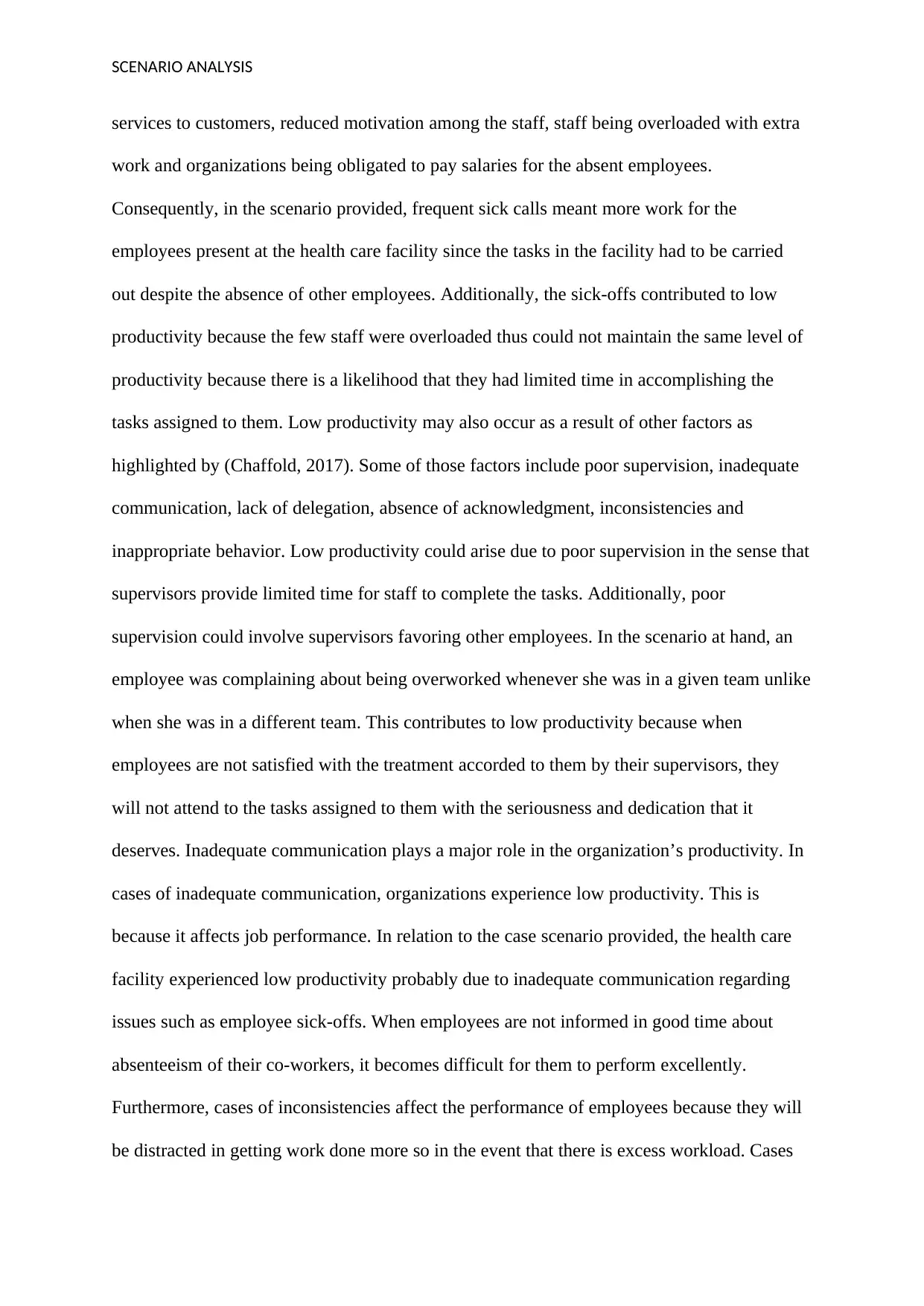
SCENARIO ANALYSIS
services to customers, reduced motivation among the staff, staff being overloaded with extra
work and organizations being obligated to pay salaries for the absent employees.
Consequently, in the scenario provided, frequent sick calls meant more work for the
employees present at the health care facility since the tasks in the facility had to be carried
out despite the absence of other employees. Additionally, the sick-offs contributed to low
productivity because the few staff were overloaded thus could not maintain the same level of
productivity because there is a likelihood that they had limited time in accomplishing the
tasks assigned to them. Low productivity may also occur as a result of other factors as
highlighted by (Chaffold, 2017). Some of those factors include poor supervision, inadequate
communication, lack of delegation, absence of acknowledgment, inconsistencies and
inappropriate behavior. Low productivity could arise due to poor supervision in the sense that
supervisors provide limited time for staff to complete the tasks. Additionally, poor
supervision could involve supervisors favoring other employees. In the scenario at hand, an
employee was complaining about being overworked whenever she was in a given team unlike
when she was in a different team. This contributes to low productivity because when
employees are not satisfied with the treatment accorded to them by their supervisors, they
will not attend to the tasks assigned to them with the seriousness and dedication that it
deserves. Inadequate communication plays a major role in the organization’s productivity. In
cases of inadequate communication, organizations experience low productivity. This is
because it affects job performance. In relation to the case scenario provided, the health care
facility experienced low productivity probably due to inadequate communication regarding
issues such as employee sick-offs. When employees are not informed in good time about
absenteeism of their co-workers, it becomes difficult for them to perform excellently.
Furthermore, cases of inconsistencies affect the performance of employees because they will
be distracted in getting work done more so in the event that there is excess workload. Cases
services to customers, reduced motivation among the staff, staff being overloaded with extra
work and organizations being obligated to pay salaries for the absent employees.
Consequently, in the scenario provided, frequent sick calls meant more work for the
employees present at the health care facility since the tasks in the facility had to be carried
out despite the absence of other employees. Additionally, the sick-offs contributed to low
productivity because the few staff were overloaded thus could not maintain the same level of
productivity because there is a likelihood that they had limited time in accomplishing the
tasks assigned to them. Low productivity may also occur as a result of other factors as
highlighted by (Chaffold, 2017). Some of those factors include poor supervision, inadequate
communication, lack of delegation, absence of acknowledgment, inconsistencies and
inappropriate behavior. Low productivity could arise due to poor supervision in the sense that
supervisors provide limited time for staff to complete the tasks. Additionally, poor
supervision could involve supervisors favoring other employees. In the scenario at hand, an
employee was complaining about being overworked whenever she was in a given team unlike
when she was in a different team. This contributes to low productivity because when
employees are not satisfied with the treatment accorded to them by their supervisors, they
will not attend to the tasks assigned to them with the seriousness and dedication that it
deserves. Inadequate communication plays a major role in the organization’s productivity. In
cases of inadequate communication, organizations experience low productivity. This is
because it affects job performance. In relation to the case scenario provided, the health care
facility experienced low productivity probably due to inadequate communication regarding
issues such as employee sick-offs. When employees are not informed in good time about
absenteeism of their co-workers, it becomes difficult for them to perform excellently.
Furthermore, cases of inconsistencies affect the performance of employees because they will
be distracted in getting work done more so in the event that there is excess workload. Cases
⊘ This is a preview!⊘
Do you want full access?
Subscribe today to unlock all pages.

Trusted by 1+ million students worldwide
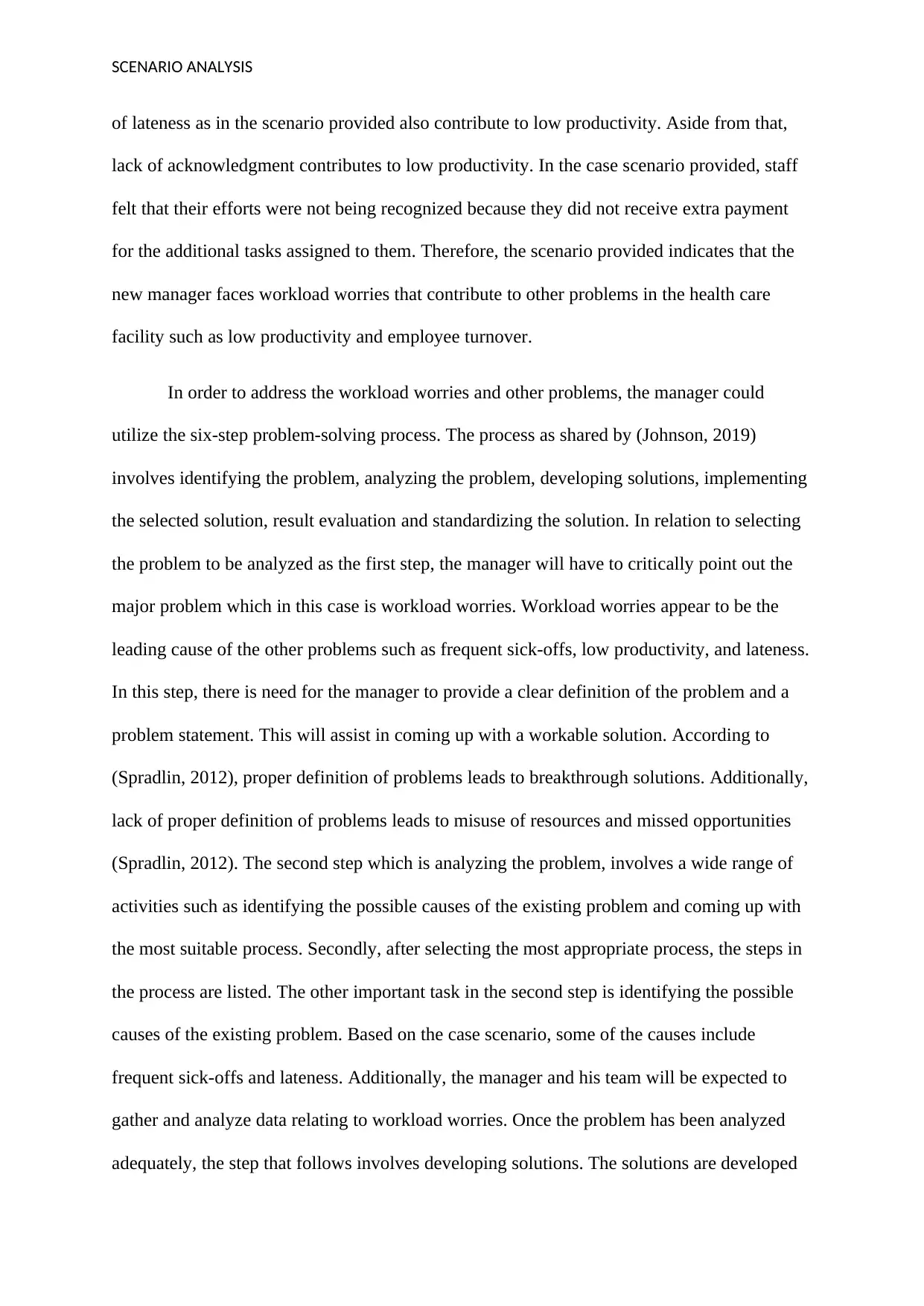
SCENARIO ANALYSIS
of lateness as in the scenario provided also contribute to low productivity. Aside from that,
lack of acknowledgment contributes to low productivity. In the case scenario provided, staff
felt that their efforts were not being recognized because they did not receive extra payment
for the additional tasks assigned to them. Therefore, the scenario provided indicates that the
new manager faces workload worries that contribute to other problems in the health care
facility such as low productivity and employee turnover.
In order to address the workload worries and other problems, the manager could
utilize the six-step problem-solving process. The process as shared by (Johnson, 2019)
involves identifying the problem, analyzing the problem, developing solutions, implementing
the selected solution, result evaluation and standardizing the solution. In relation to selecting
the problem to be analyzed as the first step, the manager will have to critically point out the
major problem which in this case is workload worries. Workload worries appear to be the
leading cause of the other problems such as frequent sick-offs, low productivity, and lateness.
In this step, there is need for the manager to provide a clear definition of the problem and a
problem statement. This will assist in coming up with a workable solution. According to
(Spradlin, 2012), proper definition of problems leads to breakthrough solutions. Additionally,
lack of proper definition of problems leads to misuse of resources and missed opportunities
(Spradlin, 2012). The second step which is analyzing the problem, involves a wide range of
activities such as identifying the possible causes of the existing problem and coming up with
the most suitable process. Secondly, after selecting the most appropriate process, the steps in
the process are listed. The other important task in the second step is identifying the possible
causes of the existing problem. Based on the case scenario, some of the causes include
frequent sick-offs and lateness. Additionally, the manager and his team will be expected to
gather and analyze data relating to workload worries. Once the problem has been analyzed
adequately, the step that follows involves developing solutions. The solutions are developed
of lateness as in the scenario provided also contribute to low productivity. Aside from that,
lack of acknowledgment contributes to low productivity. In the case scenario provided, staff
felt that their efforts were not being recognized because they did not receive extra payment
for the additional tasks assigned to them. Therefore, the scenario provided indicates that the
new manager faces workload worries that contribute to other problems in the health care
facility such as low productivity and employee turnover.
In order to address the workload worries and other problems, the manager could
utilize the six-step problem-solving process. The process as shared by (Johnson, 2019)
involves identifying the problem, analyzing the problem, developing solutions, implementing
the selected solution, result evaluation and standardizing the solution. In relation to selecting
the problem to be analyzed as the first step, the manager will have to critically point out the
major problem which in this case is workload worries. Workload worries appear to be the
leading cause of the other problems such as frequent sick-offs, low productivity, and lateness.
In this step, there is need for the manager to provide a clear definition of the problem and a
problem statement. This will assist in coming up with a workable solution. According to
(Spradlin, 2012), proper definition of problems leads to breakthrough solutions. Additionally,
lack of proper definition of problems leads to misuse of resources and missed opportunities
(Spradlin, 2012). The second step which is analyzing the problem, involves a wide range of
activities such as identifying the possible causes of the existing problem and coming up with
the most suitable process. Secondly, after selecting the most appropriate process, the steps in
the process are listed. The other important task in the second step is identifying the possible
causes of the existing problem. Based on the case scenario, some of the causes include
frequent sick-offs and lateness. Additionally, the manager and his team will be expected to
gather and analyze data relating to workload worries. Once the problem has been analyzed
adequately, the step that follows involves developing solutions. The solutions are developed
Paraphrase This Document
Need a fresh take? Get an instant paraphrase of this document with our AI Paraphraser
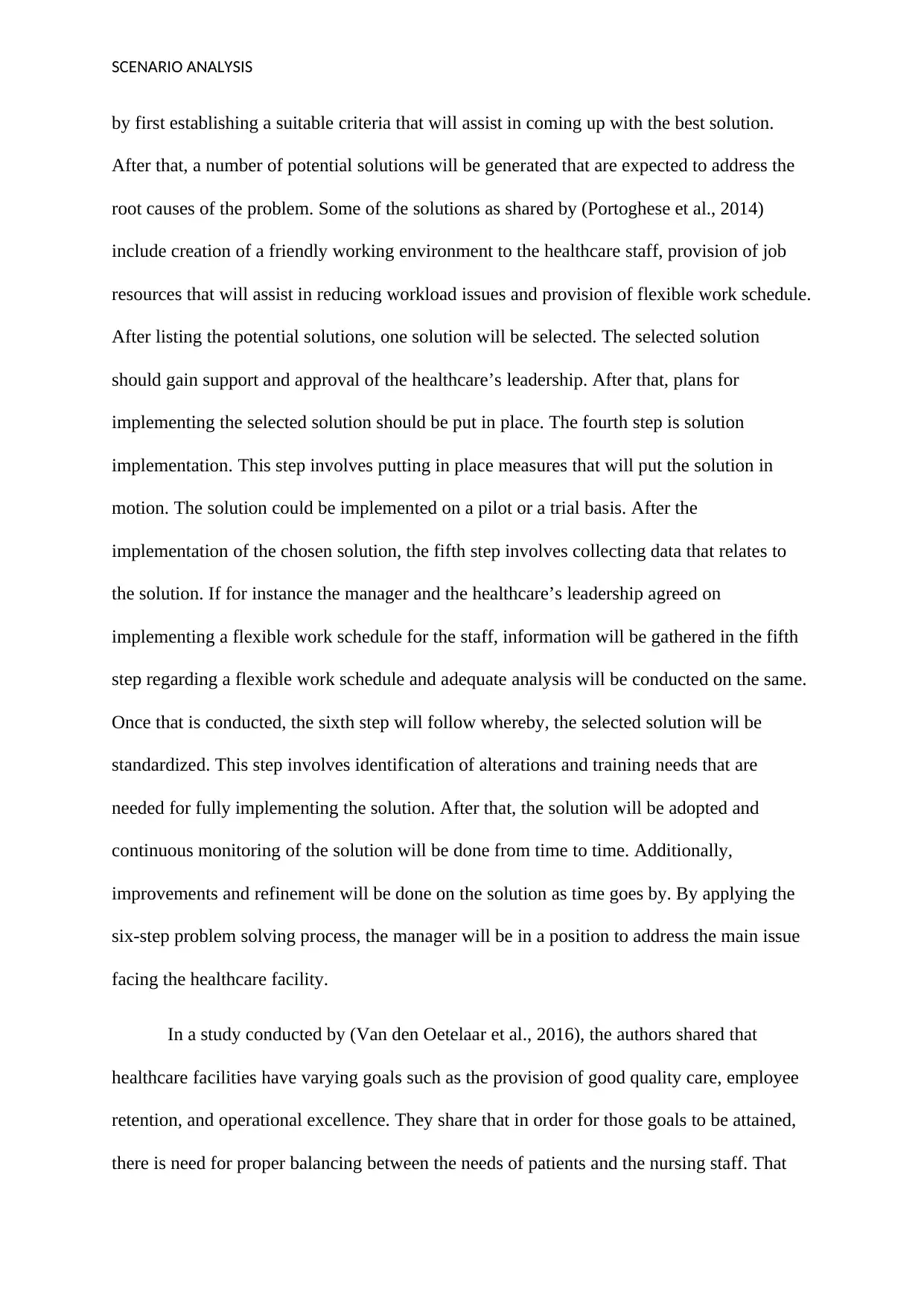
SCENARIO ANALYSIS
by first establishing a suitable criteria that will assist in coming up with the best solution.
After that, a number of potential solutions will be generated that are expected to address the
root causes of the problem. Some of the solutions as shared by (Portoghese et al., 2014)
include creation of a friendly working environment to the healthcare staff, provision of job
resources that will assist in reducing workload issues and provision of flexible work schedule.
After listing the potential solutions, one solution will be selected. The selected solution
should gain support and approval of the healthcare’s leadership. After that, plans for
implementing the selected solution should be put in place. The fourth step is solution
implementation. This step involves putting in place measures that will put the solution in
motion. The solution could be implemented on a pilot or a trial basis. After the
implementation of the chosen solution, the fifth step involves collecting data that relates to
the solution. If for instance the manager and the healthcare’s leadership agreed on
implementing a flexible work schedule for the staff, information will be gathered in the fifth
step regarding a flexible work schedule and adequate analysis will be conducted on the same.
Once that is conducted, the sixth step will follow whereby, the selected solution will be
standardized. This step involves identification of alterations and training needs that are
needed for fully implementing the solution. After that, the solution will be adopted and
continuous monitoring of the solution will be done from time to time. Additionally,
improvements and refinement will be done on the solution as time goes by. By applying the
six-step problem solving process, the manager will be in a position to address the main issue
facing the healthcare facility.
In a study conducted by (Van den Oetelaar et al., 2016), the authors shared that
healthcare facilities have varying goals such as the provision of good quality care, employee
retention, and operational excellence. They share that in order for those goals to be attained,
there is need for proper balancing between the needs of patients and the nursing staff. That
by first establishing a suitable criteria that will assist in coming up with the best solution.
After that, a number of potential solutions will be generated that are expected to address the
root causes of the problem. Some of the solutions as shared by (Portoghese et al., 2014)
include creation of a friendly working environment to the healthcare staff, provision of job
resources that will assist in reducing workload issues and provision of flexible work schedule.
After listing the potential solutions, one solution will be selected. The selected solution
should gain support and approval of the healthcare’s leadership. After that, plans for
implementing the selected solution should be put in place. The fourth step is solution
implementation. This step involves putting in place measures that will put the solution in
motion. The solution could be implemented on a pilot or a trial basis. After the
implementation of the chosen solution, the fifth step involves collecting data that relates to
the solution. If for instance the manager and the healthcare’s leadership agreed on
implementing a flexible work schedule for the staff, information will be gathered in the fifth
step regarding a flexible work schedule and adequate analysis will be conducted on the same.
Once that is conducted, the sixth step will follow whereby, the selected solution will be
standardized. This step involves identification of alterations and training needs that are
needed for fully implementing the solution. After that, the solution will be adopted and
continuous monitoring of the solution will be done from time to time. Additionally,
improvements and refinement will be done on the solution as time goes by. By applying the
six-step problem solving process, the manager will be in a position to address the main issue
facing the healthcare facility.
In a study conducted by (Van den Oetelaar et al., 2016), the authors shared that
healthcare facilities have varying goals such as the provision of good quality care, employee
retention, and operational excellence. They share that in order for those goals to be attained,
there is need for proper balancing between the needs of patients and the nursing staff. That
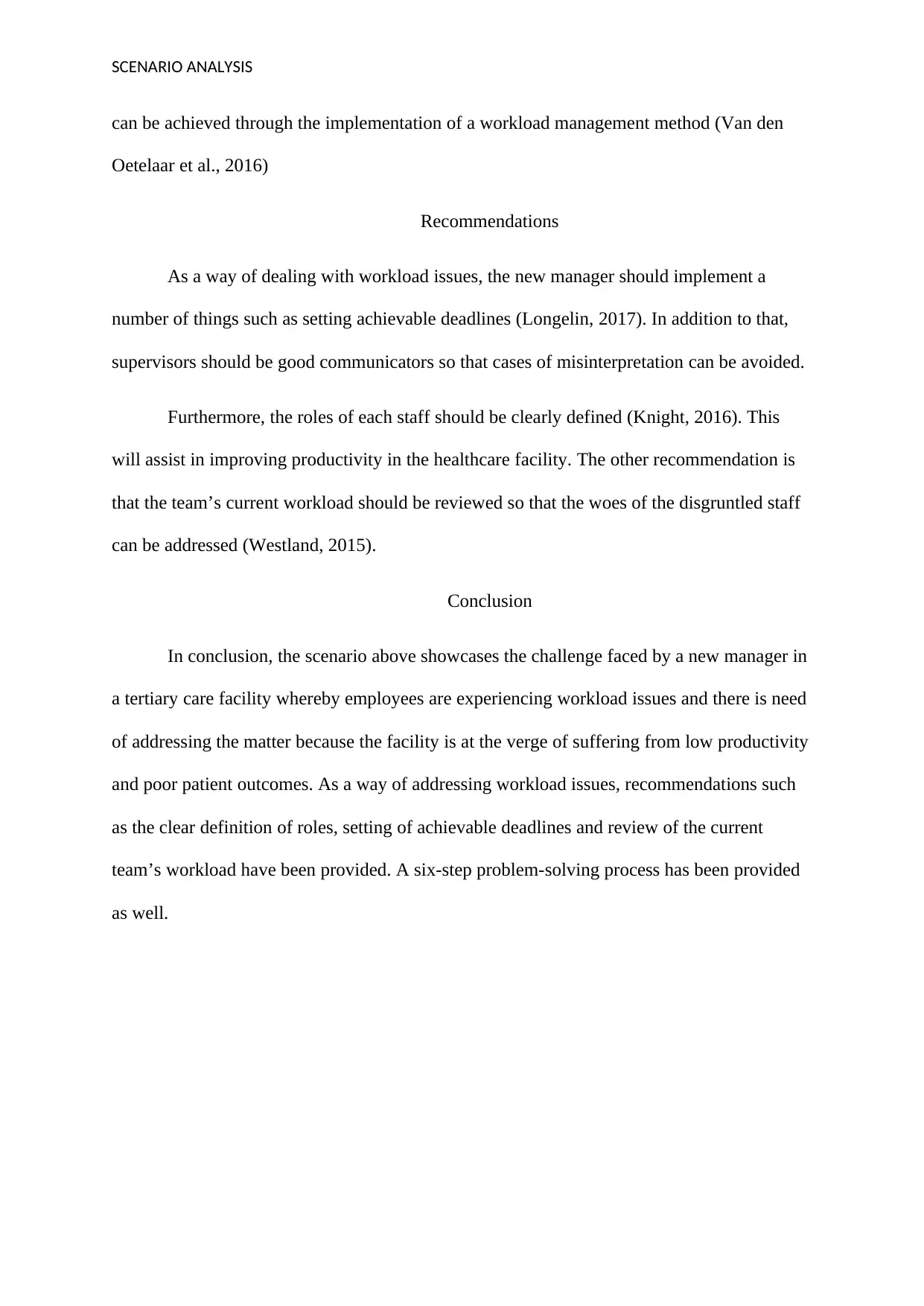
SCENARIO ANALYSIS
can be achieved through the implementation of a workload management method (Van den
Oetelaar et al., 2016)
Recommendations
As a way of dealing with workload issues, the new manager should implement a
number of things such as setting achievable deadlines (Longelin, 2017). In addition to that,
supervisors should be good communicators so that cases of misinterpretation can be avoided.
Furthermore, the roles of each staff should be clearly defined (Knight, 2016). This
will assist in improving productivity in the healthcare facility. The other recommendation is
that the team’s current workload should be reviewed so that the woes of the disgruntled staff
can be addressed (Westland, 2015).
Conclusion
In conclusion, the scenario above showcases the challenge faced by a new manager in
a tertiary care facility whereby employees are experiencing workload issues and there is need
of addressing the matter because the facility is at the verge of suffering from low productivity
and poor patient outcomes. As a way of addressing workload issues, recommendations such
as the clear definition of roles, setting of achievable deadlines and review of the current
team’s workload have been provided. A six-step problem-solving process has been provided
as well.
can be achieved through the implementation of a workload management method (Van den
Oetelaar et al., 2016)
Recommendations
As a way of dealing with workload issues, the new manager should implement a
number of things such as setting achievable deadlines (Longelin, 2017). In addition to that,
supervisors should be good communicators so that cases of misinterpretation can be avoided.
Furthermore, the roles of each staff should be clearly defined (Knight, 2016). This
will assist in improving productivity in the healthcare facility. The other recommendation is
that the team’s current workload should be reviewed so that the woes of the disgruntled staff
can be addressed (Westland, 2015).
Conclusion
In conclusion, the scenario above showcases the challenge faced by a new manager in
a tertiary care facility whereby employees are experiencing workload issues and there is need
of addressing the matter because the facility is at the verge of suffering from low productivity
and poor patient outcomes. As a way of addressing workload issues, recommendations such
as the clear definition of roles, setting of achievable deadlines and review of the current
team’s workload have been provided. A six-step problem-solving process has been provided
as well.
⊘ This is a preview!⊘
Do you want full access?
Subscribe today to unlock all pages.

Trusted by 1+ million students worldwide
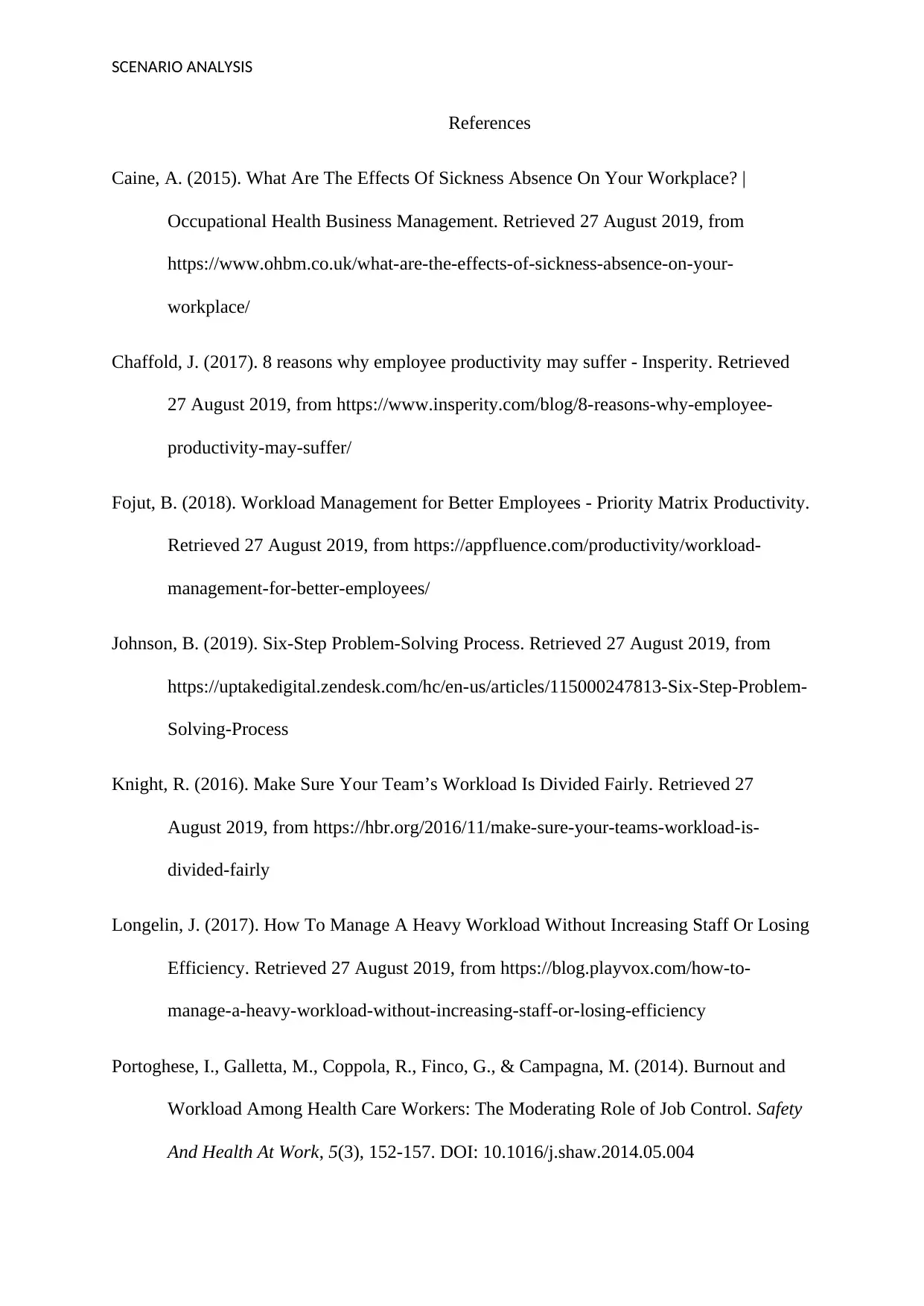
SCENARIO ANALYSIS
References
Caine, A. (2015). What Are The Effects Of Sickness Absence On Your Workplace? |
Occupational Health Business Management. Retrieved 27 August 2019, from
https://www.ohbm.co.uk/what-are-the-effects-of-sickness-absence-on-your-
workplace/
Chaffold, J. (2017). 8 reasons why employee productivity may suffer - Insperity. Retrieved
27 August 2019, from https://www.insperity.com/blog/8-reasons-why-employee-
productivity-may-suffer/
Fojut, B. (2018). Workload Management for Better Employees - Priority Matrix Productivity.
Retrieved 27 August 2019, from https://appfluence.com/productivity/workload-
management-for-better-employees/
Johnson, B. (2019). Six-Step Problem-Solving Process. Retrieved 27 August 2019, from
https://uptakedigital.zendesk.com/hc/en-us/articles/115000247813-Six-Step-Problem-
Solving-Process
Knight, R. (2016). Make Sure Your Team’s Workload Is Divided Fairly. Retrieved 27
August 2019, from https://hbr.org/2016/11/make-sure-your-teams-workload-is-
divided-fairly
Longelin, J. (2017). How To Manage A Heavy Workload Without Increasing Staff Or Losing
Efficiency. Retrieved 27 August 2019, from https://blog.playvox.com/how-to-
manage-a-heavy-workload-without-increasing-staff-or-losing-efficiency
Portoghese, I., Galletta, M., Coppola, R., Finco, G., & Campagna, M. (2014). Burnout and
Workload Among Health Care Workers: The Moderating Role of Job Control. Safety
And Health At Work, 5(3), 152-157. DOI: 10.1016/j.shaw.2014.05.004
References
Caine, A. (2015). What Are The Effects Of Sickness Absence On Your Workplace? |
Occupational Health Business Management. Retrieved 27 August 2019, from
https://www.ohbm.co.uk/what-are-the-effects-of-sickness-absence-on-your-
workplace/
Chaffold, J. (2017). 8 reasons why employee productivity may suffer - Insperity. Retrieved
27 August 2019, from https://www.insperity.com/blog/8-reasons-why-employee-
productivity-may-suffer/
Fojut, B. (2018). Workload Management for Better Employees - Priority Matrix Productivity.
Retrieved 27 August 2019, from https://appfluence.com/productivity/workload-
management-for-better-employees/
Johnson, B. (2019). Six-Step Problem-Solving Process. Retrieved 27 August 2019, from
https://uptakedigital.zendesk.com/hc/en-us/articles/115000247813-Six-Step-Problem-
Solving-Process
Knight, R. (2016). Make Sure Your Team’s Workload Is Divided Fairly. Retrieved 27
August 2019, from https://hbr.org/2016/11/make-sure-your-teams-workload-is-
divided-fairly
Longelin, J. (2017). How To Manage A Heavy Workload Without Increasing Staff Or Losing
Efficiency. Retrieved 27 August 2019, from https://blog.playvox.com/how-to-
manage-a-heavy-workload-without-increasing-staff-or-losing-efficiency
Portoghese, I., Galletta, M., Coppola, R., Finco, G., & Campagna, M. (2014). Burnout and
Workload Among Health Care Workers: The Moderating Role of Job Control. Safety
And Health At Work, 5(3), 152-157. DOI: 10.1016/j.shaw.2014.05.004
Paraphrase This Document
Need a fresh take? Get an instant paraphrase of this document with our AI Paraphraser
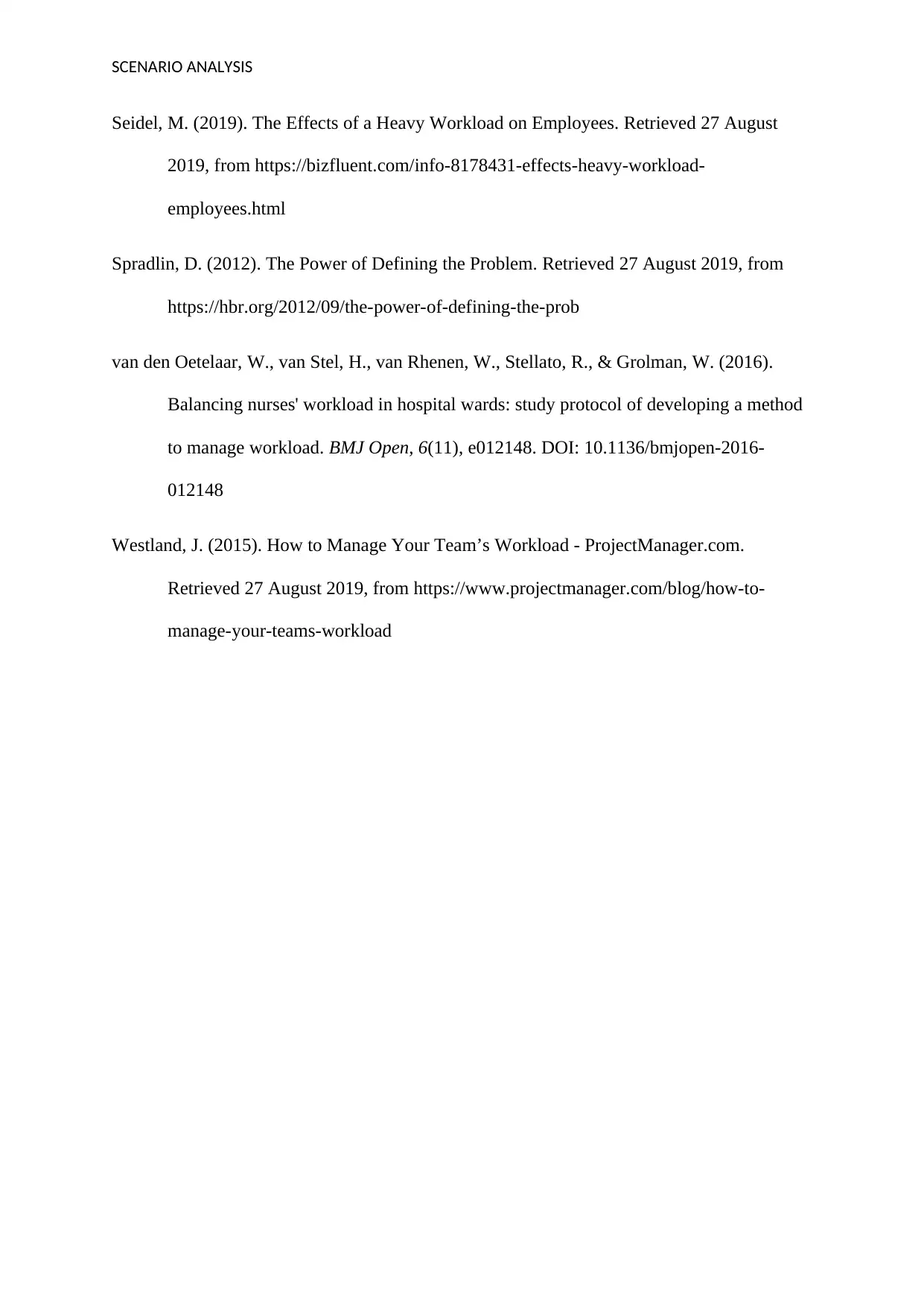
SCENARIO ANALYSIS
Seidel, M. (2019). The Effects of a Heavy Workload on Employees. Retrieved 27 August
2019, from https://bizfluent.com/info-8178431-effects-heavy-workload-
employees.html
Spradlin, D. (2012). The Power of Defining the Problem. Retrieved 27 August 2019, from
https://hbr.org/2012/09/the-power-of-defining-the-prob
van den Oetelaar, W., van Stel, H., van Rhenen, W., Stellato, R., & Grolman, W. (2016).
Balancing nurses' workload in hospital wards: study protocol of developing a method
to manage workload. BMJ Open, 6(11), e012148. DOI: 10.1136/bmjopen-2016-
012148
Westland, J. (2015). How to Manage Your Team’s Workload - ProjectManager.com.
Retrieved 27 August 2019, from https://www.projectmanager.com/blog/how-to-
manage-your-teams-workload
Seidel, M. (2019). The Effects of a Heavy Workload on Employees. Retrieved 27 August
2019, from https://bizfluent.com/info-8178431-effects-heavy-workload-
employees.html
Spradlin, D. (2012). The Power of Defining the Problem. Retrieved 27 August 2019, from
https://hbr.org/2012/09/the-power-of-defining-the-prob
van den Oetelaar, W., van Stel, H., van Rhenen, W., Stellato, R., & Grolman, W. (2016).
Balancing nurses' workload in hospital wards: study protocol of developing a method
to manage workload. BMJ Open, 6(11), e012148. DOI: 10.1136/bmjopen-2016-
012148
Westland, J. (2015). How to Manage Your Team’s Workload - ProjectManager.com.
Retrieved 27 August 2019, from https://www.projectmanager.com/blog/how-to-
manage-your-teams-workload
1 out of 8
Your All-in-One AI-Powered Toolkit for Academic Success.
+13062052269
info@desklib.com
Available 24*7 on WhatsApp / Email
![[object Object]](/_next/static/media/star-bottom.7253800d.svg)
Unlock your academic potential
Copyright © 2020–2025 A2Z Services. All Rights Reserved. Developed and managed by ZUCOL.